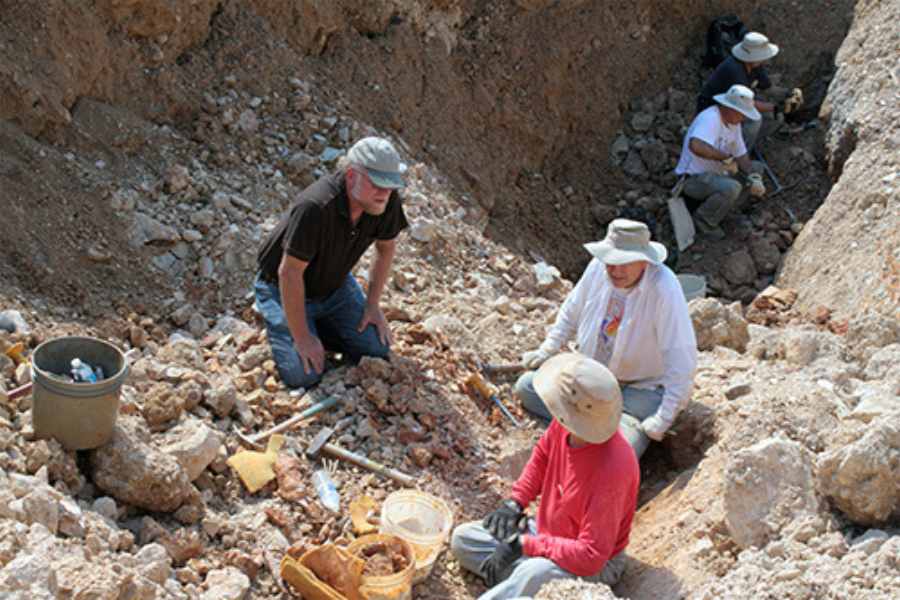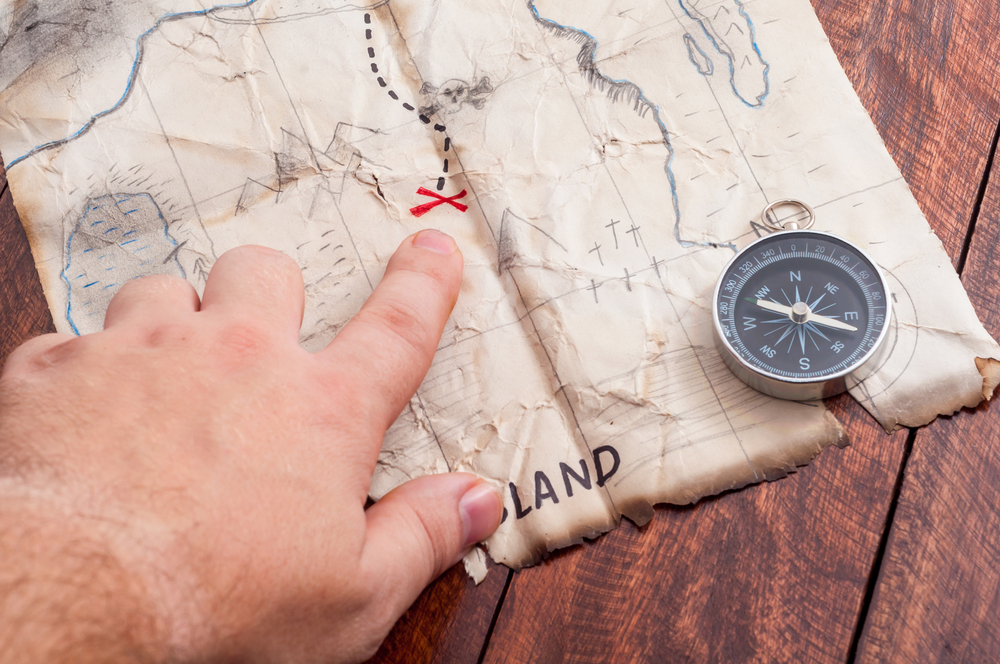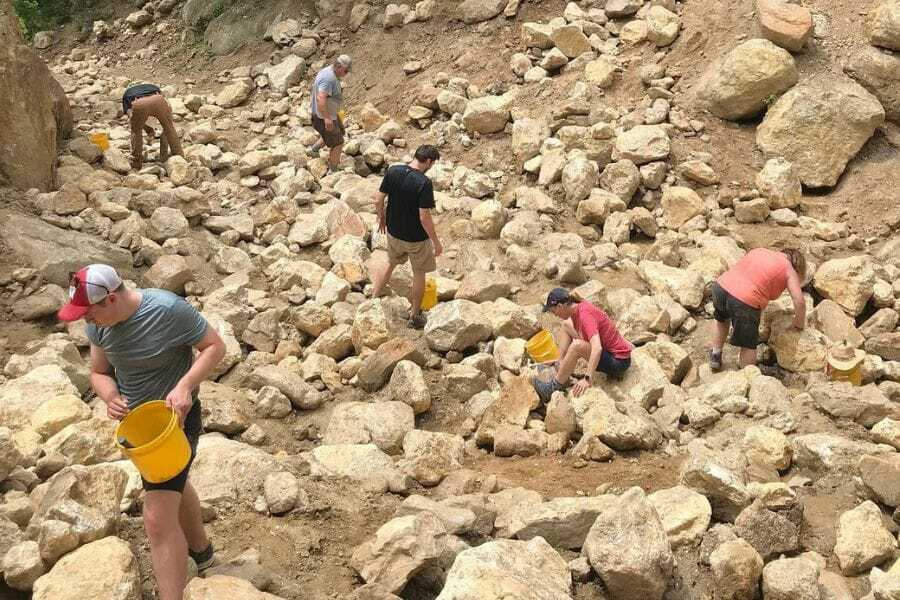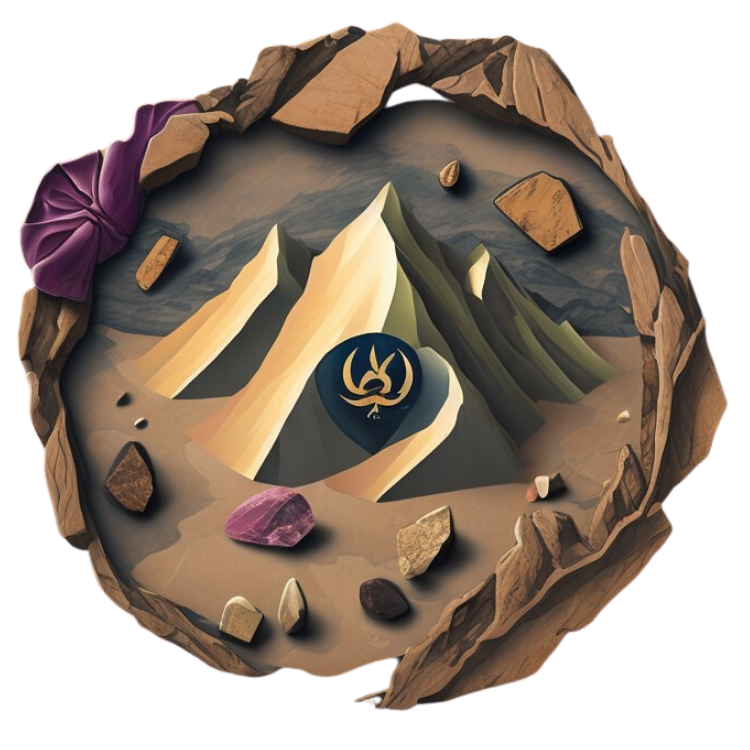Crystal Hunting Near You: Top Spots for Unearthing Gems in the US
Click here to see our crystal hunting maps
The allure of sparkling crystals, each with its unique properties and beauty, draws adventurers and collectors alike. And why not? Unearthing these precious stones from the earth is an adventure that sparks joy, connects us to nature, and adds a touch of magic to our lives. But where do you begin your crystal-hunting journey?
The United States is home to many crystal hunting spots, where you can dig, pan, or sluice for your own gems. Some of these sites are open to the public for a small fee, while others are free or require a permit. You can keep whatever you find, as long as you follow the rules and regulations of each site.
In this article, we will show you some of the best places to go crystal hunting in the US, and what kind of crystals you can expect to find there. From glistening geodes in the Midwest to sparkling amethysts in the mountains, we will also give you some tips and tricks on how to prepare for your crystal hunting adventure, and how to identify and care for your crystals. Whether you are a beginner or an expert, you will surely enjoy this guide to unearthing gems in the US.
But before we delve into the crystal hunting spots and all of the other exciting information we have for you, we would like to begin from the very basics. If you are familiar with our articles you will know that we love to lay a good foundation for our readers.
What are crystals and how are they formed?
Crystals are solid materials that have a regular and repeating pattern of atoms, molecules, or ions. They can form in different ways, such as:
- Cooling and solidification of molten rock (magma) or lava
- Evaporation or precipitation of water that contains dissolved minerals
- Changes in temperature, pressure, or chemical composition of existing rocks
- Biological processes, such as the formation of shells, bones, or teeth
Crystals can have different physical properties, such as hardness, color, luster, transparency, cleavage, fracture, and crystal system. These properties can help you identify and classify the crystals you find.
What are the benefits of crystal hunting?
Crystal hunting is more than just a hobby. It can also bring you many benefits, such as:
- Learning about geology, mineralogy, and history
- Exploring nature and discovering new places
- Exercising your body and mind
- Developing patience, perseverance, and problem-solving skills
- Enhancing your creativity and imagination
- Finding rare and valuable crystals that can be used for jewelry, decoration, or collection
- Connecting with other crystal hunters and sharing your passion
How to prepare for crystal hunting?
Before you head out to your crystal hunting destination, you need to do some preparation to make sure you have a safe and enjoyable experience. Here are some things you need to do:
- Research the site you want to visit and find out the rules, fees, hours, and availability. Some sites may require reservations, permits, or memberships. Some sites may also have seasonal or weather-related closures.
- Check the weather forecast and dress accordingly. Wear comfortable and protective clothing, shoes, gloves, and a hat. Bring sunscreen, sunglasses, insect repellent, and water. Avoid going out in extreme heat, cold, rain, or storm.
- Pack the necessary tools and equipment, such as a shovel, pick, hammer, chisel, bucket, sieve, magnifying glass, and tweezers. You may also need a map, compass, GPS, or phone for navigation. Some sites may provide or rent some of the tools, but it is better to bring your own if possible.
- Bring some snacks and drinks to keep your energy and hydration levels up. You may also want to bring a first aid kit, a whistle, a flashlight, and a fire extinguisher for emergencies.
- Respect the site and the environment. Follow the instructions and signs, and do not trespass or damage any property. Do not litter or leave any trace. Do not disturb or harm any plants or animals. Do not collect more than you need, and leave some crystals for others to enjoy.
Where to go crystal hunting in the US

Now that you are ready to go crystal hunting, let's take a look at some of the best places to find crystals in the US. We have selected nine sites that are popular among crystal hunters, and that offer a variety of crystals to suit your preferences. Here they are:
- Crater of Diamonds State Park, Arkansas
- Emerald Hollow Mine, North Carolina
- Herkimer Diamond Mines, New York
- Crystal Grove Diamond Mine, New York
- Cherokee Ruby and Sapphire Mine, North Carolina
- Gem Mountain, Montana
- Royal Peacock Opal Mine, Nevada
- Topaz Mountain, Utah
- Quartzsite, Arizona
Let's explore each site in more detail, and see what kind of crystals you can find there.
-
Crater of Diamonds State Park, Arkansas
If you are looking for diamonds, this is the place to go. Crater of Diamonds State Park is the only place in the world where you can dig for diamonds and keep what you find. The park covers a 37.5-acre volcanic crater that was formed millions of years ago, and that contains a rich deposit of diamonds and other minerals.
You can search for diamonds in the plowed fields, or the streams and ponds. You can use your tools, or rent them from the park. You can also take advantage of the Diamond Discovery Center, where you can learn how to identify and evaluate your diamonds. You can also have your diamonds certified by the park staff.
Operating Hours: The park is open year-round, except for Thanksgiving Day, Christmas Day, and New Year's Day.
Cost: The admission fee is $10 for adults, $6 for children, and free for children under 6. The park also offers camping, hiking, fishing, and other activities.
The park has produced over 75,000 diamonds since 1906, including some famous ones, such as the 40.23-carat Uncle Sam, the largest diamond ever found in the US, and the 8.52-carat Esperanza, the most valuable diamond ever found in the US. The most common color of diamonds found in the park is white, followed by brown and yellow. The average size of diamonds found in the park is about 0.25 carats, but larger ones are also possible.
-
Emerald Hollow Mine, North Carolina
If you are looking for emeralds, this is the place to go. Emerald Hollow Mine is the only emerald mine in the US that is open to the public. The mine is located in the town of Hiddenite, which is named after a rare green gemstone that is also found in the mine.
You can search for emeralds and other gemstones in three ways: digging, sluicing, or creeking. Digging involves using a shovel and a bucket to dig in designated areas. Sluicing involves using a screen box and running water to wash and sift the dirt. Creeking involves searching in the creek beds and banks. You can use your tools, or rent or buy them from the mine.
Operating Hours: The mine is open year-round, except for Thanksgiving Day, Christmas Eve, Christmas Day, and New Year's Day.
Cost: The admission fee varies depending on the method of searching, and ranges from $5 to $20 per person. The mine also offers guided tours, educational programs, and a gift shop.
The mine is famous for its emeralds, which are among the finest in the world. The most notable emerald found in the mine is the 1,686.3-carat Carolina Emperor, the largest emerald ever found in North America. The mine also produces other gemstones, such as sapphire, garnet, topaz, aquamarine, amethyst, citrine, and quartz.
-
Herkimer Diamond Mines, New York
If you are looking for quartz crystals, this is the place to go. Herkimer Diamond Mines is a group of three mines that produce quartz crystals that resemble diamonds in shape, clarity, and hardness. These crystals are also known as Herkimer diamonds and are unique to the region.
You can search for Herkimer diamonds in the open-pit mines, where you can break open the rocks with a hammer and a chisel. You can use your tools, or rent or buy them from the mines. You can also visit the museum, where you can learn about the history and geology of the mines, and see some of the best specimens.
Operating Hours: The mines are open from April to October, weather permitting.
Cost: The admission fee is $14 for adults, $12 for seniors, $11 for children, and free for children under 5. The mines also offer camping, lodging, dining, and shopping.
The mines have produced millions of Herkimer diamonds since the 18th century, and are still producing new ones every day. The average size of Herkimer diamonds is about 0.5 inches, but larger ones are also possible. The most common color of Herkimer diamonds is clear, but some may have inclusions of black carbon, water, or other minerals.
-
Crystal Grove Diamond Mine, New York
If you are looking for more quartz crystals, this is another place to go. Crystal Grove Diamond Mine is another source of Herkimer diamonds and is located near the Herkimer Diamond Mines. The mine is known for its large and high-quality crystals, and for its fluorescent minerals that glow under ultraviolet light.
You can search for Herkimer diamonds and other minerals in the mine, where you can dig, hammer, and chisel the rocks. You can use your tools, or rent or buy them from the mine. You can also use the sluice, where you can wash and sift the dirt.
Operating Hours: The opening hours are from 9:00 am to 5:00 pm, seven days a week, from April 15 to October 15, weather permitting.
Cost: The cost of entry varies depending on the type of digging, and ranges from $10.50 to $25 per person. You can also rent or buy tools from the mine.
The crystals that you will find here are Herkimer diamonds, which are quartz crystals that resemble diamonds in shape, clarity, and hardness. These crystals are unique to the region and are known for their world-class specimens of crystals on matrix and druzy. You may also find some fluorescent minerals that glow under ultraviolet light.
-
Cherokee Ruby and Sapphire Mine, North Carolina

If you are looking for rubies and sapphires, this is the place to go. Cherokee Ruby and Sapphire Mine is one of the oldest and most productive gem mines in the US. The mine is located in the Cowee Valley, which is famous for its rich deposits of corundum, the mineral that forms rubies and sapphires.
You can search for rubies and sapphires by sluicing, which involves using a screen box and running water to wash and sift the dirt. You can use your tools, or rent or buy them from the mine. You can also have your gems identified and appraised by the mine staff.
Operating Hours: The mine is open from May to October, weather permitting.
Cost: The admission fee is $20 for adults, $10 for children, and free for children under 4. The mine also offers camping, fishing, and hiking.
The mine is known for its high-quality rubies and sapphires, which come in various colors, such as red, pink, blue, purple, green, and yellow. The most notable ruby found in the mine is the 2.75-carat Cherokee Star, which was sold for $15,000. The mine also produces other gemstones, such as garnet, moonstone, quartz, and spinel.
-
Topaz Mountain, Utah
If you are looking for topaz, this is the place to go. Topaz Mountain is part of the Thomas Range, a mineral-rich area in western Utah. The mountain is famous for its sherry-colored topaz crystals, which are the state gem of Utah.
You can search for topaz by breaking open the rhyolite rocks, where the crystals are embedded. You can use your own tools, or rent or buy them from nearby vendors. You can also visit the Topaz Mountain Adventures, where you can blast the rocks with high-pressure water and collect the crystals.
Operating Hours: The mountain is open year-round, but the best time to go is in spring or fall when the weather is mild and the rocks are dry.
Cost: The admission is free, as the mountain is located on public land. The mountain also offers camping, hiking, and wildlife viewing.
The mountain is known for its high-quality topaz, which can range from clear to amber to pink. The most notable topaz found in the mountain is the 31-pound King Topaz, which was discovered in 1969. The mountain also produces other minerals, such as red beryl, garnet, amethyst, and quartz.
-
Royal Peacock Opal Mine, Nevada
If you are looking for opals, this is the place to go. Royal Peacock Opal Mine is one of the most productive opal mines in the US. The mine is located in the Virgin Valley, which is part of the Black Rock Desert, a remote and rugged area in northern Nevada.
You can search for opals by digging in the bank, where the opal-bearing clay is exposed. You can use your tools, or rent or buy them from the mine. You can also try your luck in the tailings, where the leftover rocks from previous mining are dumped. You can keep any opals you find, as long as they are not claimed by the mine owners.
Operating Hours: The mine is open from May to October, weather permitting.
Cost: The admission fee varies depending on the type of digging, and ranges from $75 to $190 per person. The mine also offers camping, lodging, and tours.
The mine is famous for its black fire opals, which are the most valuable and rarest type of opals. The opals have a dark background and a vivid play of colors, which can include red, orange, yellow, green, blue, and purple. The most notable opal found in the mine is the 130-pound Royal Peacock, which was discovered in 1992. The mine also produces other types of opals, such as white, crystal, and lemon.
-
Quartzsite, Arizona
If you are looking for quartz, this is the place to go. Quartzsite is a small town in southwestern Arizona, near the border with California. The town is surrounded by mountains and deserts, where quartz crystals are abundant and diverse.
You can search for quartz by exploring the public lands, where you can collect up to 25 pounds of rocks per day. You can use your tools, or buy them from local shops. You can also visit the Quartzsite Rock and Gem Show, which is held every year in January and February and attracts thousands of vendors and buyers from all over the world.
Operating Hours: The town is open year-round, but the best time to go is in winter when the weather is cool and the rock show is on.
Cost: The admission is free, as the town is located on public land. The town also offers camping, RV parks, museums, and events.
The town is known for its wide variety of quartz, which can include clear, smoky, rose, amethyst, citrine, and agate. The most notable quartz found in the town is the 700-pound Quartzsite Crystal, which was discovered in 1989. The town also produces other rocks and minerals, such as turquoise, jasper, calcite, and gold.
Other Great Crystal Hunting Sites in the US
- Salt Plains National Wildlife Refuge, Oklahoma: A 32,197-acre refuge in north-central Oklahoma, where you can dig for selenite crystals. The crystal digging season is from April 1 to October 15, and admission is free. You can keep up to 10 pounds of crystals per day.
- Rainbow Ridge Opal Mine, Nevada: One of the most productive opal mines in the Virgin Valley, Nevada. Open from Memorial Day to mid-September, and the admission fee is $190 per person for digging in the bank, or $75 per person for digging in the tailings. You can keep all the opals you find.
- Bonanza Opal Mine, Nevada: Another source of black fire opals in the Virgin Valley. Open on weekends from late May to Labor Day. Admission fee is $70 per person for adults, and free for children under 12. You can keep all the opals you find.
- Wegner Quartz Crystal Mine, Arkansas: A popular destination for quartz crystal digging in Arkansas. Open year-round, admission fee varies from $10.50 to $25 per person. You can keep all the crystals you find.
- Himalaya Tourmaline Mine, North Carolina: The only emerald mine in the US open to the public, located in Hiddenite, North Carolina. The mine produces emeralds, sapphires, garnets, topaz, aquamarine, amethyst, citrine, and quartz crystals. Admission fee varies from $5 to $20 per person. You can keep all the gemstones you find.
Read this article "Finding Rockhounding Locations in the United States." For more details on locations near you where you can rockhound and find other exciting rocks, minerals, and fossils.
How to care for your crystals
After you have found your crystals, you need to take good care of them to preserve their beauty and energy. Here are some tips on how to care for your crystals:
- Clean your crystals regularly, especially after digging or handling them. You can use water, soap, vinegar, or salt to remove any dirt or dust. You can also use a soft brush or cloth to gently wipe them.
- Charge your crystals periodically, especially if you use them for healing or meditation. You can use sunlight, moonlight, fire, earth, or other crystals to recharge your crystals. You can also use sound, intention, or prayer to activate them.
- Store your crystals properly, especially if you have a large collection of delicate specimens. You can use boxes, bags, cases, or displays to protect your crystals from damage or loss. You can also use labels, cards, or catalogs to identify and organize your crystals.
Conclusion
Embarking on a crystal-hunting adventure can be an enriching experience, allowing you to connect with nature and uncover the beauty hidden beneath the earth's surface. As you plan your next crystal-hunting excursion, consider these top spots in the United States, each offering a unique and rewarding opportunity to find these captivating gems.
Remember the Ethics: Always follow responsible collecting practices. Obtain proper permits when required, respect private property, and leave no trace behind. By being mindful of our impact, we can ensure these crystal treasures remain available for future generations to enjoy.
